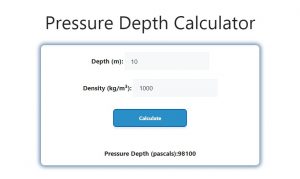About Pressure Depth Calculator (Formula)
The Pressure Depth Calculator is a vital tool in various fields such as engineering, oceanography, and physics. It allows users to calculate the pressure exerted by a fluid at a specific depth, which is crucial for designing structures, analyzing fluid dynamics, and understanding natural phenomena. By knowing the pressure at different depths, engineers and scientists can make informed decisions in their respective fields. In this article, we will discuss the formula used in the Pressure Depth Calculator, how to use it effectively, provide a practical example, and answer common questions related to this topic.
Formula
The formula for calculating pressure at a specific depth in a fluid is:
P = d * p * g
Where:
- P represents the pressure at depth.
- d is the depth of the fluid.
- p is the density of the fluid.
- g is the acceleration due to gravity.
How to Use
- Determine the Depth (d): Identify the depth at which you want to calculate the pressure. This is usually measured in meters.
- Identify the Fluid Density (p): Find out the density of the fluid you are working with. The density is typically expressed in kilograms per cubic meter (kg/m³).
- Know the Acceleration Due to Gravity (g): The standard acceleration due to gravity on Earth is approximately 9.81 m/s².
- Input Values into the Formula: Substitute the values of depth (d), fluid density (p), and gravitational acceleration (g) into the formula: P = d * p * g.
- Calculate the Pressure: Perform the calculation to find the pressure at the specified depth.
Example
Suppose you want to calculate the pressure at a depth of 10 meters in water, which has a density of approximately 1000 kg/m³.
- Depth (d): 10 m
- Density of Water (p): 1000 kg/m³
- Acceleration Due to Gravity (g): 9.81 m/s²
Using the formula:
P = d * p * g
P = 10 m * 1000 kg/m³ * 9.81 m/s²
P = 98,100 Pascals (Pa)
This result indicates that at a depth of 10 meters in water, the pressure is 98,100 Pascals.

FAQs
- What is the Pressure Depth Calculator?
It is a tool used to calculate the pressure exerted by a fluid at a specific depth. - Why is pressure depth important?
Understanding pressure at various depths is crucial for designing underwater structures and studying fluid behavior. - What does the variable P represent?
P represents the pressure at the specified depth. - What does the variable d stand for?
d stands for the depth of the fluid. - What is the significance of fluid density (p)?
Fluid density affects the amount of pressure exerted at a given depth; denser fluids exert more pressure. - How does gravity affect pressure calculations?
Gravity contributes to the weight of the fluid above, thus influencing the pressure at depth. - Can the calculator be used for gases?
Yes, it can be used for gases, but the density and behavior may vary compared to liquids. - Is the value of g constant everywhere?
While g is approximately 9.81 m/s² on Earth, it can vary slightly depending on location. - What are some applications of pressure depth calculations?
Applications include underwater construction, diving, and studying oceanographic phenomena. - How do temperature changes affect fluid density?
Temperature changes can alter the density of a fluid, impacting pressure calculations. - Can I use this calculator for different types of fluids?
Yes, but you must know the density of each specific fluid. - What happens to pressure as depth increases?
As depth increases, pressure also increases due to the weight of the fluid above. - How accurate are pressure depth calculations?
Accuracy depends on the precision of depth, density, and gravitational values used. - What units are used for pressure?
Pressure is commonly measured in Pascals (Pa) or atmospheres (atm). - How can I convert between pressure units?
You can use conversion factors (1 atm = 101,325 Pa) to switch between units. - Is the calculator relevant for high-pressure environments?
Yes, it can be used in high-pressure scenarios, such as deep-sea exploration. - What equipment is needed to measure depth accurately?
Depth can be measured using pressure sensors, depth gauges, or sonar equipment. - What is the impact of buoyancy on pressure readings?
Buoyancy can affect the perceived weight of an object in a fluid but does not change the pressure calculation. - Are there online calculators available for pressure depth calculations?
Yes, many websites offer online calculators for quick computations. - How often should pressure depth calculations be performed in field applications?
Regular calculations are recommended, especially in dynamic environments like oceans or lakes.
Conclusion
The Pressure Depth Calculator is an essential tool for understanding the relationship between depth and pressure in fluids. By using the formula P = d * p * g, users can easily compute the pressure exerted at any depth, aiding in engineering, scientific research, and various practical applications. Regularly utilizing this calculator can enhance safety and efficiency in projects involving fluids, ensuring accurate assessments and informed decision-making. Whether you are working in oceanography, engineering, or any field involving fluids, mastering pressure depth calculations is crucial for success.